How Many CFM Do I Need For My Range Hood?

This is one of the most common questions we are asked here at Proline. Let’s talk about how many CFM you need to keep your kitchen clean and free of lingering smells.
The ventilation power of your range hood is measured in cubic feet per minute (CFM). CFM is how many cubic feet of air the range hood exhausts every minute at full speed. Simply put, the higher the CFM, the more air the hood vents out of your kitchen.
To power your range hood, you need at least 100 CFM for every 10,000 BTUs of your stovetop. For example, a 100,000 BTU stove needs at least a 1000 CFM range hood. For electric stoves, multiply the stove width by 10. So, for a 42” electric stove you want a range hood with at least 420 CFM.
To vent cooking exhaust from your kitchen efficiently, we recommend a range hood with at least 600 CFM.
Keep in mind that there is no ideal range hood CFM, but instead, an appropriate CFM based on your cooking style and habits in the kitchen. The best range hood is different for everyone. It depends not only on your cooktop but on your cooking style as well.
Table of Contents
1. Type of Range and Output
Range hoods over electric and gas cooktops, along with outdoor grills, require different CFM ratings.
Electric
Range hood CFM over an electric stove depends on the width of your range. Simply multiply the width of your stove by 10 to get the appropriate CFM for your range hood. For example, if your cooktop is 36”, this calls for at least a 360 CFM hood.
Learn more about venting your electric stove in this article.
Gas
Gas ranges produce a lot more heat and fumes compared to an electric range so you’ll want more range hood CFM. The amount of heat emitted from a gas cooktop is measured in British thermal units (BTUs).
BTUs describe the amount of heat required to raise the temperature of a pound of water by one degree Fahrenheit. Burners range from 400 BTUs to 18,000 BTUs, but most will fall somewhere in between.
To determine the CFM of a hood over a gas range, add up the BTU output of each burner and divide it by 100.
For example, if you have two burners that put out 10,000 BTUs each and two burners that put out 15,000 BTUs each, your total BTUs for your stovetop would be 50,000. 50,000 divided by 100 equals 500 CFM. So, you’ll want a range hood that moves at least 500 CFM of air.
Because gas stoves generate more concentrated fumes, it is better to err on the side of caution and choose a higher CFM.
Learn more about venting your gas stove in our article ‘Do gas ranges require venting?‘
Outdoor Grills
Remember, your outdoor grill has higher BTUs than an indoor cooktop. It may have side burners and other equipment that produce more fumes. Calculate your outdoor grill’s minimum CFM needs the same way as your gas stove: determine the total BTUs and divide by 100. To learn more about range hood CFM for your outdoor hood, check out this complete guide.
2. Size of Your Kitchen

When shopping for a range hood, it’s important to understand how the volume of your kitchen affects your range hood CFM. In general, larger kitchens will need to move more smoke and unwanted air to keep the air clean and harsh cooking odors at bay.
Here’s how to calculate exactly how much CFM you need based on the size of your kitchen.
First, determine the volume of your kitchen.
To calculate your kitchen’s size in cubic feet, multiply the length by the width and height.
For example, your kitchen is 18’ long x 14’ wide x 9’ tall = 2,268 cubic feet.
Now, as an accepted rule for ventilation, a range hood needs to have the power to exchange your kitchen’s air 15 times per hour. To get the number of cubic feet moved per hour, multiply your kitchen’s cubic feet by the air exchanges per hour.
For example, 2,268 cubic feet x 15 air exchanges = 34,020 cubic feet per hour.
Next divide by minutes in an hour. 34,020 cubic feet ÷ 60 minutes per hour = 567.
Or, you can also simply divide the volume of your kitchen by 4 as every 4 minutes, your air needs to be exchanged (60/4 = 15 air exchanges). So, you’re left with 2,268 cubic feet ÷ 4 minutes = 567.
In this example, you’ll want a minimum of 567 CFM for this size of the kitchen.
Next, calculate the CFM requirements for your cooktop (total BTUs/100) and compare that to the number you calculated for the volume of your kitchen.
Finally, take the larger number and use it as the minimum CFM requirement for your new range hood. When in doubt, go with a larger CFM range hood, since you unfortunately can’t increase range hood CFM. This gives you more flexibility in the kitchen.
3. Cooking Routines
Your habits in the kitchen can influence whether you opt for a higher CFM kitchen range hood. Ask yourself a few questions to figure out what kind of routines you have and whether your unique cooking situation requires more powerful ventilation.
Frequency
How often do you cook? Do you make all your meals on your cooktop? Do you use all the burners at once?
Types of Foods
What kinds of foods do you like to cook? Do you cook a lot of fish and other foods with a strong odor?
Styles of Cooking
What styles of cooking do you prefer? Do you love to cook greasy foods? Do you fry foods on high heat? Or do you use a lot of oil? Do you regularly steam foods?
Are you a fan of Asian cooking? Do you cook fajitas, pizza, or other similar foods that produce a lot of smoke?
If you enjoy using your stovetop frequently or like to cook with fish and spicy foods or prepare meals that require high heat such as wok style cooking, go with a higher CFM range hood.
4. Ductwork

Your range hood ductwork has a significant impact on your CFM needs. If you are building a new kitchen, you’ll need to install proper ducting for your vent hood.
But if your ducting is already in place and you don’t plan on modifying it, you’ll need to consider duct length, shape, and size before deciding on your range hood CFM.
For older, less powerful range hoods, ducting sizes tend to be four to six inches in diameter. However, higher CFM ratings require larger diameters of eight to 10 inches. A larger duct requires more CFM and a smaller duct requires less.
Without an adequate size duct, a higher-CFM blower will encounter too much air resistance to work effectively. Smoke and steam will stay in your kitchen, as well as cooking odors, which is not ideal.
But if the size of your duct matches your ventilation power, your kitchen exhaust fan will do its job properly and quietly.
A good rule of thumb for estimating duct diameter and CFM requirements is:
- 400 to 600 CFM = 6” to 8” duct
- 700 to 900 CFM = 7” to 10” duct
- 900 to 1200 CFM = 8” to 12” duct
- 1200 and higher CFM = 10” and up duct
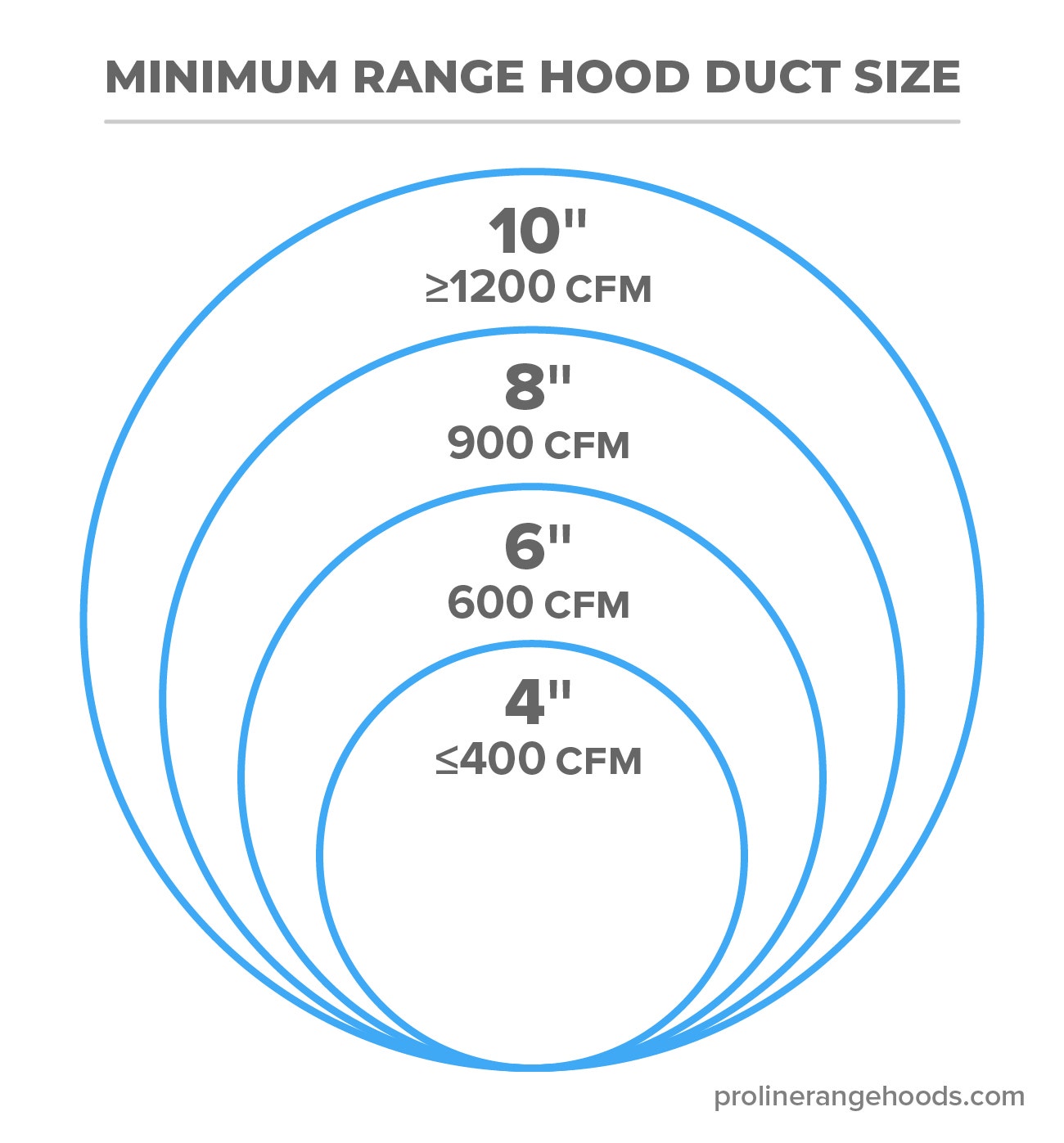
Keep in mind that you can never have ductwork that is too wide. Larger ducting gives your kitchen air more space to move.
Besides the duct diameter, the length, the number of turns and whether you have a roof cap all influence CFM. Here is a formula to help you estimate your CFM based on your ducting:
- For each foot of ductwork, increase your CFM by 1.
- For each turn in your duct, increase your CFM by 25.
- If you have a roof cap, increase your CFM by 40.
For example, you have 12 feet of pipe, 2 turns and a roof cap: (12’ pipe x 1 CFM) + (2 turns x 25 CFM) + 40 CFM roof cap = 102 CFM. Now, you will need to add 102 CFM to the minimum amount from the chart.
**If you want to check out some of our customer’s hoods in their beautiful kitchens and hear directly from them, check out this article: Inspiring Proline Customer Kitchen Creations | Ep. 4
How do you calculate CFM for a range hood?
- Determine the volume of your kitchen.
- Multiply that number by 15, the standard number of times a range hood should exchange all the air in your kitchen per hour.
- Divide that number by 60 to get the minimum cubic feet per minute for your hood.
- Divide the total BTUs of your kitchen range by 100.
- Compare these two numbers and go with the larger amount.
- For each foot of ductwork, increase your CFM by 1.
- For each turn in your duct, increase your CFM by 25.
- If you have a roof cap, increase your CFM by 40.
- Look for a hood with at least the total CFM you calculated in steps 1-8.
If we use the examples from above, it will look like this:
We have calculated 380 CFM based on the width of the range hood, 500 CFM based on the burner output, and 567 CFM from the kitchen volume. The highest of these values is 567, so we will use that in our calculation. 567 + 102 (from the above ductwork calculations) = 669 CFM.
Be sure that this answer lies within the higher end of the recommended CFM based on the chart below. Otherwise, it will have to be adjusted.

After all this, factor in your cooking routines. Frequent cooks will require more CFM to vent the dirty air and smoke outside their home and keep the space free of strong odors.
How many CFM do I need for a 36” gas range?
Take the total BTUs of your cooktop by adding up the BTUs of each burner and divide that by 100 to get the CFM. So, if your range produces a total of 60,000 BTUs, your range hood must be at least 600 CFM.
The more heat your range produces, the more CFM you need for your kitchen range hood.
Keep in mind that other factors like length of ductwork, number of elbows, and the size of your kitchen may impact the CFM.
For example, if you have really long ductwork with three elbows (not recommended, but it can happen) you’ll need much more CFM than shorter ductwork with no elbows.
In most kitchens, the above calculation will work great.
Is 400 CFM enough for my range hood?
If you used the above calculations to calculate your CFM (total BTUs of your range / 100) and came up 400 or less, then that amount of power will work great for you. But, in most cases, this won’t be powerful enough to clean your kitchen air efficiently. Your range will likely produce too many BTUs for a 400 CFM hood.
You can purchase range hoods 400 CFM and under at several big box stores, but they will not match the quality of range hoods with a higher CFM rating.
We recommend high-CFM hoods to our customers because they can always use them on lower speeds. But, if you purchase a 400 CFM range hood and you realize you want 900 CFM, there’s unfortunately not much you can do about that.
For more information on choosing the right CFM for your vent hood, check out our full article Is 400 CFM enough for my range hood?
Is it better to have a higher CFM?

A higher CFM is ideal because it allows you to cook a wider variety of foods compared to weaker hoods, while keeping your kitchen air clean and fresh. But it is not always your best option if you:
- Have a small kitchen where the air pulled into your hood is greater than the air coming into your kitchen
- Have a hood with small diameter ductwork that won’t support a higher CFM
- Run your AC and heater often – the cool and warm air will leave your home, which is your money going out the door
If your range hood lacks variable speeds, you will have no choice but to run it at a higher cubic feet per minute than you might need when you’re cooking less intensively.
This means you will be removing more air from your kitchen than is necessary, potentially causing you to lose the heat you want in your home. You’ll also lose the money it costs to run the hood at its max speed.
If your hood isn’t sized properly, a higher CFM will not necessarily help you eliminate all the fumes. As mentioned above, your ductwork impacts the capacity of a high power blower to remove air. Your hood will not be able to do its job if your ductwork is too small, too long, or has too many bends.
Every situation is different, but you’ll never regret buying a more powerful fan. We get calls every week from people that regret not getting enough before so they are looking for a new hood now.
Keep in mind that you won’t be running it on its max speed all the time. Most Proline range hoods come with at least four fan speed options, so you can adjust the power of the kitchen exhaust fan to meet the requirements of any type of food preparation.
Do I need makeup air for my range hood?
There’s a commonly held myth that you need makeup air for range hoods that are more powerful than around 300 or 400 CFM. But makeup air is not required for your range hood unless…
- Your building codes require makeup air
- You have a 1200+ CFM kitchen range hood in a small kitchen
- You use your high CFM range hood often
For more information on makeup air, check out our article here.
What is the minimum duct size for a range hood?
The minimum recommended duct size is 6” for 0-400 CFM range hoods. The smaller the duct size, the less CFM you need. The larger the duct size, the more CFM you need.
For more information on duct size, click here!
How many CFM do I need for my range hood? – Some Other Considerations
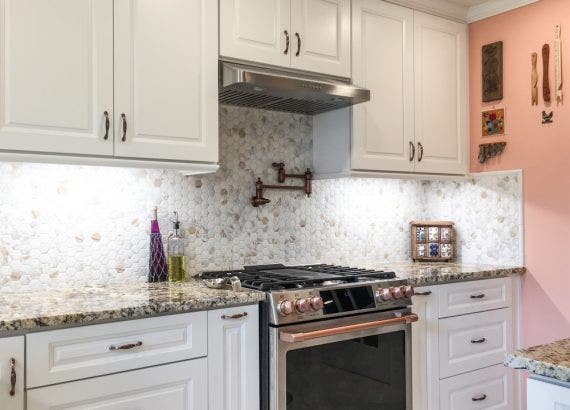
Range Hood Size
Take note of the size and position of your range hood. If it is not at least six inches larger than your range, you won’t be able to maximize the power of your hood fan. Range hoods need to have the proper amount of overhang and depth for them to work effectively.
The further your hood extends past the edges of your cooktop, the better – particularly if you have an island range. Be sure your hood is at least a size or two up from your stove or has three to six inches overhang. If you have an outdoor kitchen, aim for your hood to extend six to 12 inches past the cooktop.
Mounting Height
If your range hood vent is installed more than 36” above the stovetop, you will require higher CFM to remove air contaminants properly and your hood will struggle to do its job effectively.
On the other hand, if the range hood is positioned too close to the cooking surface, it will not be able to effectively capture the cooking air either. It can also heat up too much as you are cooking and the life of your hood can be greatly reduced. Your vent hood must be installed between 28” to 36” inches away from the cooktop to maximize your ventilation power.
For more information on mounting your range hood, check out this ultimate guide.
Noise Level (Sones)
If you’re sensitive to sound, you should be aware of how loud your range hood will be. The faster you run your hood fan, the louder the noise. Some things can help mitigate this, though.
If you scale up the size of the hood it will make less sound. Proline’s larger hoods have more efficient and thus quieter fans. With a larger capacity, you will be able to run your hood at lower and quieter speeds as well.
Also, you can opt for an inline or remote blower instead of an internal one. This means the noisy part, the blower, of the range hood will be further away from you and it will be much quieter. More on the different types of blowers here.
Filters
The more frequently you cook, the more often you’ll have to clean your grease filters. Proline’s stainless steel baffle filters capture grease efficiently and they are dishwasher-safe.
Now that you’ve calculated the minimum requirements for your range hood’s CFM, remember that, in most cases, it’s a good idea to scale it up.
Scaling up is especially beneficial for island range hoods, which are exposed to your kitchen air on all sides. In contrast, a wall mount range hood is exposed to air from three sides; the back wall behind your range helps funnel the air through your hood to the outside. For this reason, wall mount range hoods don’t need as much CFM to keep your air clean.
Wherever your needs fit within these considerations, Proline has the right range hood for you!
The most popular range hoods from big box stores are available at 250 CFM, 300 CFM, and 400 CFM. However, at Proline, we sell a wide variety of exhaust fans: wall mount range hoods, range hood inserts, island range hoods, under cabinet range hoods, and outdoor range hoods ranging from 600 CFM to 2000 CFM – the most powerful range hoods for your home on the market.
Other CFM FAQ
How many CFM do you need per BTU?
For an increase of 1 CFM, you need 1/100th of a BTU. The reason this number is so low is that residential range hoods max out at around 2000 CFM, while the number of BTUs in your kitchen is commonly in the hundreds of thousands or even millions. Another way to think about the relationship between BTUs and CFM is to divide the total BTUs by 100 to get the CFM you need for your range hood.
What is the difference between SCFM and CFM?
SCFM, or standard cubic feet per minute, is a CFM measurement based on a standard temperature, pressure, and humidity. CFM, on the other hand, does not take variables like temperature and pressure into account. For this reason, it is a slightly less accurate measurement of fan power. That being said, most bathroom fans and range hoods are measured in CFM while air tools use SCFM.
What is a good CFM for a leaf blower?
You can find a powerful, professional-quality leaf blower at 300 CFM on Amazon. For the average homeowner, this is a great option. If you use your leaf blower a lot, you might consider a 400+ CFM blower so you can finish your job in the yard quickly.
How much CFM do I need for an air compressor?
Most air compressors power air tools between 70 pounds per square inch (PSI) and 120 PSI. The smaller the air tool, the less CFM your air compressor requires. A 10 CFM air compressor will work for most people, however, some of the larger tools require 15 CFM or more.
The CFM requirement should be printed on the package that your tool came in. To ensure that you have enough power, multiply that number by at least 1.5 to find the appropriate CFM. If you own several types of air tools, make sure that your compressor can power the one that requires the most CFM.
Recap
We hope you found your answer to the question: how many CFM do I need for my range hood? Calculating CFM for range hoods is easy to do.
Let’s recap some of the biggest takeaways about range hood CFM below:
- To calculate range hood CFM, divide the total BTUs produced by your cooktop by 100. This is a minimum amount that will fluctuate based on your cooking style.
- More cubic feet per minute is almost always better since you can run your range hood on lower speeds if you don’t use the max power often.
- Range hoods from big box stores do not have enough power to vent all the smoke from your cooking space and are not made with high-quality materials. Instead, look for a range hood that is at least 600 CFM.
Once you determine the CFM you want, you’re well on your way to finding the best range hood for you.
When selecting a kitchen range hood, the CFM needed extends beyond just meeting the minimum requirement. A higher CFM range hood provides greater air movement, better able to pull air, remove heat, and vent harmful fumes from the cooking area. For larger kitchens or high BTU ranges, an under cabinet or wall mounted hood with additional CFM may be necessary to match the total cubic feet and cooking habits of the space.
Conversely, smaller kitchens or those with lower BTU outputs may do well with a standard cabinet range hood, prioritizing aesthetics over maximum ventilation power. The final CFM calculation should account for range size, kitchen layout, and availability of outside ventilation, as linear feet of ductwork and elbows will require even higher CFM to overcome those obstacles.
Ultimately, choosing a kitchen range hood with the right CFM for your space, cooking needs, and ventilation setup is key to maintaining a comfortable, fresh-smelling kitchen free from lingering odors and temperature fluctuations. Whether opting for under cabinet, wall, or standard models, ensuring sufficient air movement is critical for proper heat and cold air removal.
Related Articles
Is 300 CFM enough for my range hood?
Best 1200 CFM Range Hoods and Buyer’s Guide
As an Amazon Associate, we earn from qualifying purchases.
How many CFM do I need for my range hood?
To power your range hood, you need at least 100 CFM for every 10,000 BTUs of your stovetop. For example, a 100,000 BTU stove needs at least a 1000 CFM range hood. For electric stoves, multiply the stove width by 10. So, for a 42” electric stove you want a range hood with at least 420 CFM.
To vent cooking exhaust from your kitchen efficiently, we recommend a range hood with at least 600 CFM.
Keep in mind that there is no ideal range hood CFM, but instead, an appropriate CFM based on your cooking style and habits in the kitchen. The best range hood is different for everyone. It depends not only on your cooktop but on your cooking style as well.
How do you calculate CFM for a range hood?
1. Determine the volume of your kitchen.
2. Multiply that number by 15, the standard number of times a range hood should exchange all the air in your kitchen per hour.
3. Divide that number by 60 to get the minimum cubic feet per minute for your hood.
4. Divide the total BTUs of your kitchen range by 100.
5. Compare these two numbers and go with the larger amount.
6. For each foot of ductwork, increase your CFM by 1.
7. For each turn in your duct, increase your CFM by 25.
8. If you have a roof cap, increase your CFM by 40.
9. Look for a hood with at least the total CFM you calculated in steps 1-8.
How many CFM do I need for a 36” gas range?
Take the total BTUs of your cooktop by adding up the BTUs of each burner and divide that by 100 to get the CFM. So, if your range produces a total of 60,000 BTUs, your range hood must be at least 600 CFM.
Is 400 CFM enough for my range hood?
If you used the above calculations to calculate your CFM (total BTUs of your range / 100) and came up 400 or less, then that amount of power will work great for you. But, in most cases, this won’t be powerful enough to clean your kitchen air efficiently. Your range will likely produce too many BTUs for a 400 CFM hood.
You can purchase range hoods 400 CFM and under at several big box stores, but they will not match the quality of range hoods with a higher CFM rating.
We recommend high-CFM hoods to our customers because they can always use them on lower speeds. But, if you purchase a 400 CFM range hood and you realize you want 900 CFM, there’s unfortunately not much you can do about that.
Do I need makeup air for my range hood?
There’s a commonly held myth that you need makeup air for range hoods that are more powerful than around 300 or 400 CFM. But makeup air is not required for your range hood unless…
Your building codes require makeup air
You have a 1200+ CFM kitchen range hood in a small kitchen
You use your high CFM range hood often
For more information on makeup air, check out our article here.
What is the minimum duct size for a range hood?
The minimum recommended duct size is 6” for 0-400 CFM range hoods. The smaller the duct size, the less CFM you need. The larger the duct size, the more CFM you need.
For more information on duct size, click here!
How many CFM do you need per BTU?
For an increase of 1 CFM, you need 1/100th of a BTU. The reason this number is so low is that residential range hoods max out at around 2000 CFM, while the number of BTUs in your kitchen is commonly in the hundreds of thousands or even millions. Another way to think about the relationship between BTUs and CFM is to divide the total BTUs by 100 to get the CFM you need for your range hood.
What is the difference between SCFM and CFM?
SCFM, or standard cubic feet per minute, is a CFM measurement based on a standard temperature, pressure, and humidity. CFM, on the other hand, does not take variables like temperature and pressure into account. For this reason, it is a slightly less accurate measurement of fan power. That being said, most bathroom fans and range hoods are measured in CFM while air tools use SCFM.
What is a good CFM for a leaf blower?
You can find a powerful, professional-quality leaf blower at 300 CFM on Amazon. For the average homeowner, this is a great option. If you use your leaf blower a lot, you might consider a 400+ CFM blower so you can finish your job in the yard quickly.
How much CFM do I need for an air compressor?
Most air compressors power air tools between 70 pounds per square inch (PSI) and 120 PSI. The smaller the air tool, the less CFM your air compressor requires. A 10 CFM air compressor will work for most people, however, some of the larger tools require 15 CFM or more.
The CFM requirement should be printed on the package that your tool came in. To ensure that you have enough power, multiply that number by at least 1.5 to find the appropriate CFM. If you own several types of air tools, make sure that your compressor can power the one that requires the most CFM.




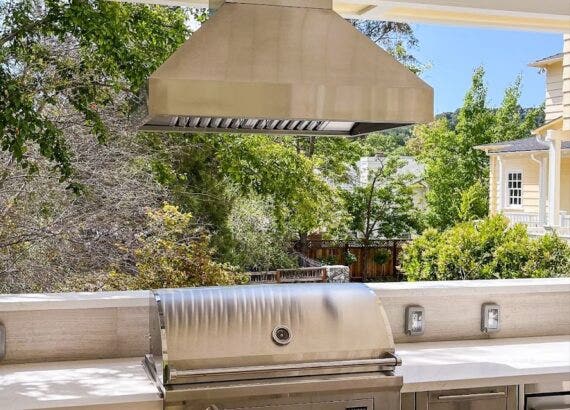
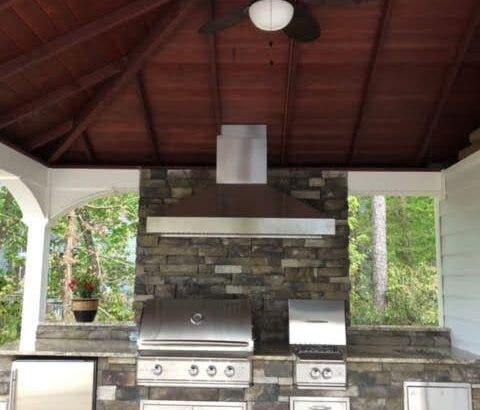
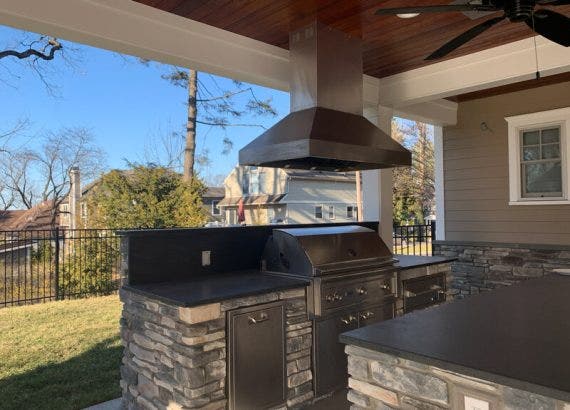
Comments are closed.